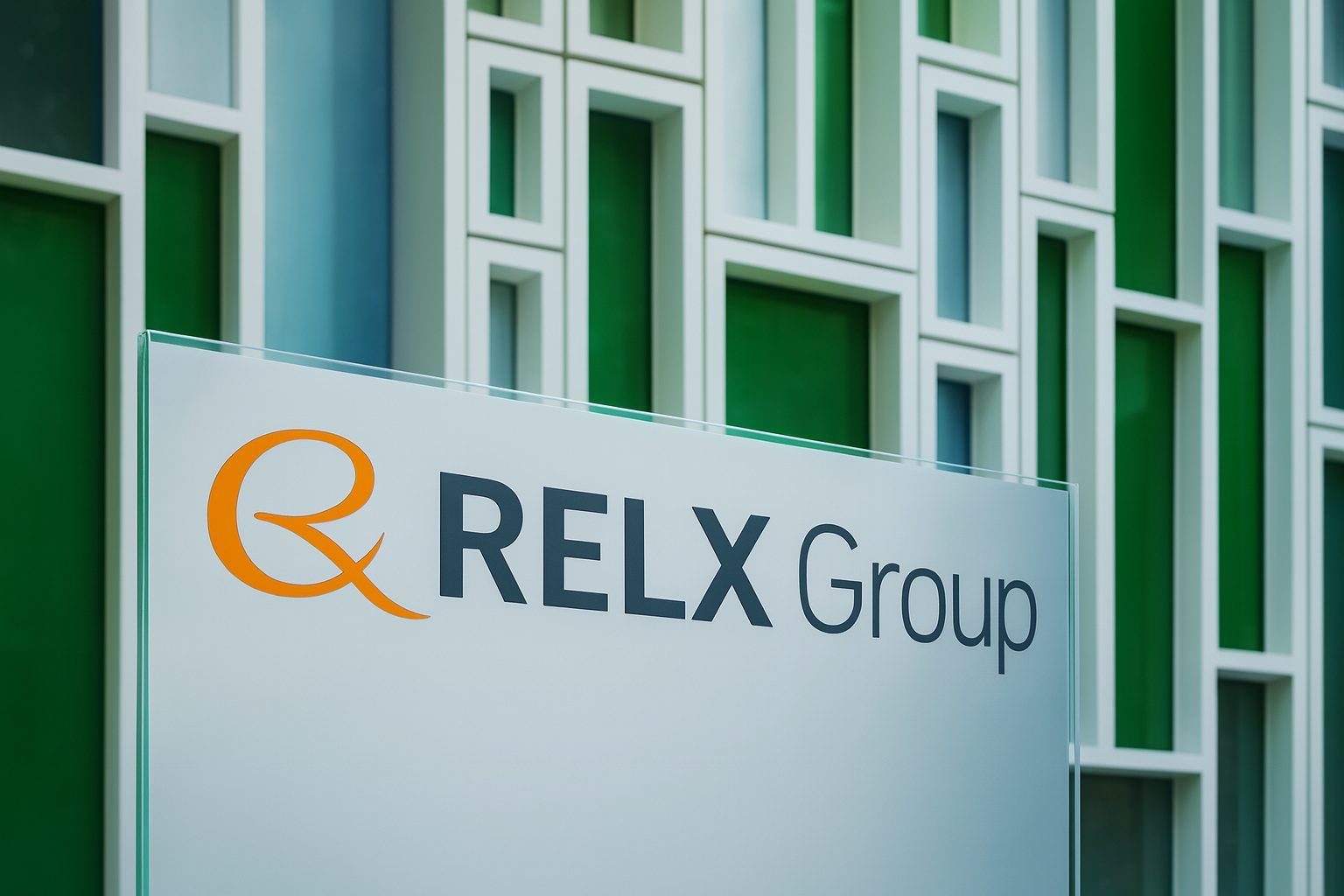RELX PLC, the FTSE 100 data and analytics group behind brands such as LexisNexis and Elsevier, is back in focus on Thursday, 27 November 2025, as investors digest fresh regulatory news on an additional share listing, continued buybacks and a high‑profile feature on the company’s transformation into an AI‑driven powerhouse.
- Share price today: RELX trades around 3,038–3,039p in London, up slightly on the day but still hovering just above its 52‑week low of 3,011p and well below its 2025 highs near 4,205p. [1]
- Additional Listing: The company has applied for a block listing of 60,000 new shares tied to its employee Save As You Earn (SAYE) share option scheme, with admission expected on 1 December 2025. [2]
- Latest buyback: On 26 November 2025, RELX repurchased 60,800 shares for treasury as part of its ongoing £1.5bn buyback, taking 2025 repurchases to roughly 39.4 million shares. [3]
- Fundamentals: The group continues to deliver mid‑single‑digit revenue growth and high‑single‑digit profit growth in 2025, driven by AI‑enabled analytics across Risk, STM, Legal and Exhibitions. [4]
- Big‑picture story: A new Financial Times piece highlights RELX’s shift from legacy print publishing to a mostly digital, AI‑driven data business, with more than 80% of revenue now digital and a market cap of about £56bn. [5]
RELX share price today: trading just above 52‑week lows
On the London Stock Exchange, RELX shares are changing hands at around 3,038–3,039p this afternoon, up roughly 0.3% from yesterday’s close of 3,028p. The intraday trading range has been tight, with an open at 3,025p, a high near 3,046p and a low around 3,022p. [6]
Even after today’s modest bounce, the shares sit close to their 52‑week low of 3,011p, and around 28% below the 2025 peak of 4,205p set in February, underlining how far the stock has corrected despite resilient operating performance. [7]
In New York, the RELX ADR (ticker RELX) recently traded around $40.3, only a few percent above its own 52‑week low of $39.31 and well below the 52‑week high of $56.33. [8]
For context, that means the market is currently valuing RELX close to the bottom of its one‑year trading range, even as management reiterates guidance for another year of strong growth in revenue, profit and earnings per share.
Additional Listing: 60,000 new shares for the SAYE employee scheme
The main new regulatory headline around RELX this week is an “Additional Listing” announcement published on 26 November 2025 and picked up by market data providers today.
According to the RNS, RELX has applied to the Financial Conduct Authority (FCA) and the London Stock Exchange for a block listing of 60,000 ordinary shares of 14 51/116p each. The new shares are being issued in connection with the RELX Group plc 2013 Save As You Earn (SAYE) Share Option Scheme. [9]
Once admitted, these shares:
- Will trade on the LSE like existing ordinary shares.
- Will be admitted to the FCA’s Official List.
- Will rank pari passu with existing issued share capital (same rights to dividends and votes). [10]
Admission is expected on 1 December 2025, so today’s news is mainly about preparation: making sure RELX has enough listed shares available to satisfy options granted to employees under the SAYE plan, rather than raising fresh capital. [11]
Given that RELX has more than 1.82 billion shares in issue, this extra 60,000 represents a tiny fraction of the share base and is not expected to be materially dilutive. [12]
Buyback update: 60,800 shares repurchased on 26 November
Alongside the additional listing, RELX continues to lean heavily on share buybacks as a way of returning cash to shareholders.
A fresh RNS titled “Transaction in Own Shares”, dated 26 November 2025, confirms that RELX:
- Bought back 60,800 ordinary shares on the LSE.
- Executed the trades through JP Morgan Securities plc.
- Paid between 3,023p and 3,075p per share, at a volume‑weighted average price of 3,041.07p. [13]
After this transaction:
- RELX holds 58,996,289 shares in treasury.
- It has 1,823,968,670 ordinary shares in issue (excluding treasury shares).
- Since 2 January 2025, the company has repurchased 39,388,619 shares in total. [14]
These routine buyback notices may look small in isolation, but they are part of a much larger programme. In its first‑half 2025 results, RELX said it had a £1.5bn share buyback planned for the year:
- £1.0bn was already completed in the first half.
- A further £75m was bought back between 1 July and the results date.
- The remaining £425m was scheduled to be deployed before year‑end 2025. [15]
With the share price now near the bottom of its 12‑month range, each pound of buyback spending cancels more shares than it would have at the start of the year, mechanically boosting earnings per share over time – assuming the business continues to grow.
FT spotlight: from print journals to AI‑driven data giant
Away from the RNS feed, RELX also gets a major piece of editorial coverage today. A long Financial Times feature titled “Relx thrives by swapping journals for data” charts how the company has reinvented itself over the past two decades. [16]
Key points from the article (summarised):
- RELX has shifted from being a traditional publisher of titles like Farmers Weekly and New Scientist to a data and analytics business whose portfolio now includes LexisNexis and a wide range of decision‑support tools.
- More than 80% of revenue now comes from digital sources, compared with about 20% at the turn of the century. Advertising has shrunk from over a third of group revenue to less than 1% today.
- The company sold its last major print title, Estates Gazette, earlier this year, completing its pivot away from print.
- Under CEO Erik Engstrom and CFO Nick Luff, RELX has generated around 380% share‑price growth over 20 years and total shareholder returns of roughly 2,200% since the 1993 Reed‑Elsevier merger, according to FT calculations.
- RELX is presented as a UK corporate AI champion, having been early to adopt machine learning and generative AI in its tools. It now offers more than 15 generative AI products, notably for lawyers using LexisNexis.
The FT also notes that RELX’s market capitalisation of about £56bn makes it the largest media and technology company in the FTSE 100, ahead of well‑known names such as Barclays. [17]
For today’s news flow, the piece reinforces a central message: while the share price has had a rough 12 months, the group’s long‑term strategy of using proprietary data and AI to build high‑value decision tools remains intact.
2025 performance: solid growth across all segments
Company‑supplied numbers for 2025 so far back up that narrative of steady, tech‑driven growth.
H1 2025 results
In July 2025, RELX reported for the first half of the year: [18]
- Revenue: £4,741m (vs. £4,641m a year earlier), with underlying revenue up 7%.
- Adjusted operating profit: £1,652m, with underlying growth of 9% and an improved adjusted operating margin of 34.8%.
- Adjusted EPS: 63.5p, up 10% at constant currency.
- Interim dividend: up 7% year‑on‑year to 19.5p.
- Cash conversion: 100%, with net debt / EBITDA at 2.2x, comfortably within management’s target range.
The half‑year update also confirmed that RELX completed three acquisitions and two small disposals in H1, continuing its pattern of bolt‑on deals rather than large, transformational M&A. [19]
October 2025 trading update
On 23 October 2025, RELX issued a trading update for the first nine months of the year, saying it had delivered: [20]
- Underlying revenue growth year‑to‑date of 7%.
- Strong contributions from all four major segments:
- Risk: +8% underlying revenue growth YTD, driven by AI‑enabled analytics in financial crime compliance, fraud and identity, and insurance.
- Scientific, Technical & Medical (STM): +5%, helped by new AI‑powered tools for researchers and growing article submissions.
- Legal: +9%, supported by higher‑value legal analytics and the rapid rollout of Lexis+ AI and related tools such as the Protégé AI legal assistant.
- Exhibitions: +8%, with events fully back and enhanced by digital add‑ons.
Management reiterated that it expects another year of strong underlying growth in revenue, adjusted operating profit and adjusted EPS for 2025, continuing a multi‑year trend of high‑single‑digit expansion. [21]
How the market and analysts are reading RELX now
Despite the recent share price weakness, both analysts and institutional investors continue to frame RELX as a high‑quality, long‑term compounder.
- A recent analyst roundup suggests a “moderate buy” consensus rating on REL/RELX, with around three buy ratings and one hold. The average 12‑month price target implies roughly 45–50% upside from current London levels, according to MarketBeat and other aggregators. [22]
- Longer‑term modelling by Simply Wall St points to forecast annual earnings growth of about 10% and revenue growth around 6%, with a projected return on equity above 70% in three years – numbers that reflect RELX’s asset‑light, high‑margin, data‑driven business model. [23]
On the ownership side, recent SEC filings and fund factsheets picked up in TechStock²’s RELX coverage show:
- New or increased positions from several North American institutional investors, including AlphaCore Capital and Northern Trust, in the New York‑listed ADR.
- RELX holding top‑tier positions in major UK and European equity funds, such as Finsbury Growth & Income Trust and certain MSCI‑tracking ETFs, cementing its role as a structural holding in many global portfolios. TechStock²
In short, although the share price has slid to near 52‑week lows, much of the professional investor base appears to be holding or adding, rather than exiting.
What today’s developments mean for RELX shareholders
Putting everything together, today’s 27 November 2025 RELX news flow tells a consistent story:
- The Additional Listing of 60,000 shares is mainly administrative, ensuring RELX can honour employee options under the SAYE scheme while maintaining orderly trading in its stock.
- The latest 60,800‑share buyback continues a £1.5bn capital‑return programme, which, at today’s depressed valuation, cancels a meaningful chunk of equity and supports long‑term EPS growth. [24]
- Operationally, RELX is still delivering solid growth across all divisions, powered by AI‑enabled analytics and sticky subscription revenues. [25]
- Strategically, today’s FT feature reinforces the view of RELX as a mature but still evolving tech‑driven data business, rather than a cyclical publisher. [26]
For investors, the key questions now are less about today’s small incremental RNSs and more about:
- Execution: Can RELX keep converting its deep data sets into differentiated AI‑powered tools faster than competitors?
- Valuation vs. growth: Does high‑single‑digit earnings growth, strong cash generation and extensive buybacks justify paying up from today’s near‑trough multiples?
- Macro and regulatory risk: How will changes in data‑privacy rules, AI regulation and the broader economic cycle affect demand for its risk, legal and STM products? [27]
As always, this article is for information only and does not constitute investment advice. Anyone considering buying or selling RELX shares should do their own research or consult a qualified financial adviser, taking into account their personal financial situation and risk tolerance.
References
1. www.lse.co.uk, 2. www.lse.co.uk, 3. www.investegate.co.uk, 4. www.relx.com, 5. www.ft.com, 6. www.lse.co.uk, 7. markets.ft.com, 8. markets.ft.com, 9. www.lse.co.uk, 10. www.lse.co.uk, 11. www.lse.co.uk, 12. www.investegate.co.uk, 13. www.investegate.co.uk, 14. www.investegate.co.uk, 15. www.relx.com, 16. www.ft.com, 17. www.ft.com, 18. www.relx.com, 19. www.relx.com, 20. www.relx.com, 21. www.relx.com, 22. www.marketbeat.com, 23. simplywall.st, 24. www.investegate.co.uk, 25. www.relx.com, 26. www.ft.com, 27. www.relx.com








